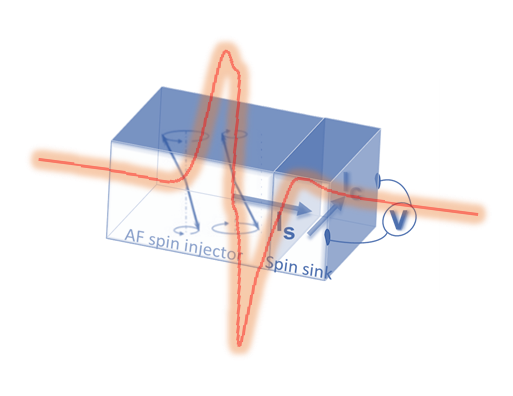The SPINTEC laboratory in Grenoble, France, is seeking a PhD candidate for a joint application to a specific PhD studentship program. The joint application is to be submitted by March 2020 for a studentship available for admission in October 2020, for 3 years. Excellent academic record is mandatory. Applicants should have a Master’s degree in Physics, good practical skills, and the will to pursue work on experimental physics, material science, and solid state physics. A CV and Masters’ transcripts are to be sent to Vincent BALTZ, vincent.baltz@cea.fr and Ursula EBELS, ursula.ebels@cea.fr.
The object of the PhD work will be to explore the fundamental mechanisms of antiferromagnetic spintronics in the sub-THz to THz frequency range. You will benefit from the holistic knowhow in Grenoble: SPINTEC (V. Baltz and U. Ebels) [1,2], LNCMI (A.-L. Barra) [3], and national and international collaborations [4]. You will work with state of the art techniques of fabrication and characterization at the nanoscale, cryogenic temperatures, strong magnetic fields (15 T) and large frequencies (600 GHz).
More specifically, the transfer of angular momentum between photons, phonons and electrons in antiferromagnets is a vast subject of fundamental research that could pave the way for the generation, manipulation and electrical conversion of chiral antiferromagnetic spin waves in the sub-THz to THz frequency range. The THz dynamics of the antiferromagnetic order parameter is directly related to the internal exchange interactions between the spin sub-lattices (~100T), which is several orders of magnitude larger than the internal fields involved in the GHz dynamics of ferromagnetic materials. Furthermore, the presence of two spin sub-lattices in antiferromagnets allows the propagation of spin waves of opposite chirality. This property suggests the unique possibility of propagating magnonic currents of opposite direction, opening the pathway for binary encoded spin waves: ‘0’ and ‘1’. In addition to this, there is currently little or no reliable and inexpensive technology to generate and detect radiations in the frequency band between 0.1 and 15 THz of the electromagnetic spectrum. Several types of applications would use this range, e.g. in the fields of health (medical imaging), telecommunications (transceivers), and security (scanners). Spintronic devices based on the coherent dynamics of the antiferromagnetic order parameter are theoretically well adapted to handle this frequency range and could allow bridging this THz gap. The aim of this PhD is to experimentally explore these theoretical predictions.
[1] V. Baltz et al, Rev. Mod. Phys. 90, 015005 (2018) ; L. Frangou et al, Phys. Rev. Lett. 116, 077203 (2016)
[2] D. Houssameddine, U. Ebels et al, Nat. Mater. 6, 447 (2007)
[3] Y. Li, A.-L. Barra et al, Phys. Rev. B 92, 140413 (2015)
[4] R. Lebrun et al, Nature 561, 222 (2018)
Keywords : THz electronics, Antiferromagnetic spintronics, Spin transport, Spin-orbit coupling





